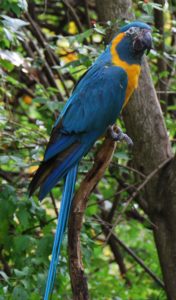
Blue-throated macaws are large colorful parrots native to Bolivia. They are one of the rarest in the world. Their upper parts are turquoise-blue, slightly duller on the crown and brighter on the rump. Underparts are largely bright yellow but the vent is pale blue. Despite being plentiful in captivity, these beautiful and intelligent birds are critically endangered in the wild and are protected by trading prohibitions. Macaws are very intelligent and relatively easy to train. They are a favorite for shows and trick training. Blue-throated macaws are very inquisitive, mischievous, animated and love to chew. They should always be provided with toys, especially wooden blocks that can be chewed, and branches from non-toxic trees. Blue-throated macaws are social birds; they are most frequently seen in pairs, but in the wild also gather in small groups of 7 to 9 individuals and sometimes may roost in groups of 70. Their main mode of locomotion is flying, but they are also able to climb trees, maneuver along branches and walk on the ground. These birds are active during the day and usually, stay in one general area. Blue-throated macaws communicate mostly by sound. When they suspect danger, they emit a very loud alarming call and promptly fly off. These birds also communicate with each other with quiet caws.